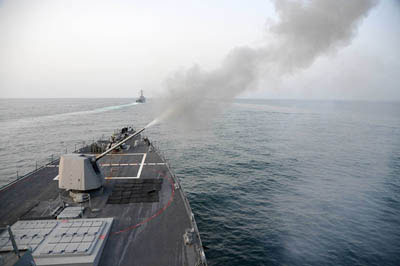

Vol. 77/No. 12 April 1, 2013

|
| US Navy photo by Mass Communication Specialist 3rd Class Declan Barnes |
| Guided-missile destroyer USS McCampbell conducts live firing exercise March 15 during two-month-long military maneuvers by U.S.-South Korean forces aimed at North Korea. |
Under Washington’s prodding, the U.N. Security Council voted March 7 to impose tougher sanctions on North Korea. The resolution, co-drafted by the U.S. government and Beijing, slaps new restrictions on North Korea’s financial transactions, credit and overseas travel; calls for stiffer interdiction of its ships and aircraft; and expands the list of banned imports and targeted companies, organizations and individuals. This latest round of crippling economic measures comes on the heals of a Jan. 22 U.N. Security Council resolution imposing sanctions on North Korean banks and other entities.
“The next step includes strong implementation [of economic sanctions] in coordination with China,” said Susan Rice, U.S. ambassador to the U.N., following the Security Council’s 15-0 vote on the most recent resolution. “There are still very real limitations on how far [Beijing] is prepared to go on a national and bilateral basis to squeeze the [North Korean] regime.” China, which borders North Korea, is the country’s main trading partner.
Meanwhile, U.S. and South Korean forces are engaged in two simultaneous large-scale joint military maneuvers in South Korea involving more than 13,000 U.S. troops and as many as 200,000 South Korean soldiers, as well as nuclear-capable bombers and naval vessels. The largest of the two exercises, Foal Eagle, runs from March 1 to April 30.
On March 15, Defense Secretary Chuck Hagel announced the Pentagon would add 14 new anti-missile interceptors at Fort Greely in Alaska and move ahead with a second missile-defense radar in Japan.
US simulates nuclear bombing raids
Deputy Secretary of Defense Ashton Carter told reporters March 18 that the U.S. would carry out its second simulated nuclear B-52 bombing raid the next day as part of the current joint exercises. Carter was in Seoul for two days of meetings with top South Korean government officials to “discuss the latest security situation on the Korean Peninsula,” according to South Korea’s defense ministry.U.S. bombers were not armed with nuclear weapons, Pentagon press secretary George Little told the media the same day. Carter added, “We remain steadfast to our commitment to extended deterrence offered by the U.S. nuclear umbrella.”
A March 20 statement from the North Korean Foreign Ministry called the B-52 involvement in the drills “an unpardonable provocation” and warned at counteraction if it was repeated. During a joint military maneuver in November 2010 simulating an invasion of the North, artillery fire was exchanged between South Korean troops on the island of Yeonpyeong and North Korean forces. Four were killed and 18 injured on the South Korean side, according to government officials there. Pyongyang said Seoul had “recklessly fired into our sea area” and warned that if South Korean forces enter its territory it would “unhesitatingly continue taking merciless military counteractions.”
On March 13 Pyongyang blamed South Korea and the U.S. for cyberattacks on government servers. South Korea denied the charge and the U.S. military declined to comment.
A week later computer networks at several major broadcasters and banks in South Korea reportedly suffered cyberattacks of their own.
Crisis rooted in imperialist division of Korea
The current crisis is rooted in the 1945 division of the Korean nation, imposed against the will of its people by U.S. imperialism, in accord with the Soviet Union. After imposing a brutal puppet dictatorship in the South, Washington carried out a bloody war under the blue U.N. flag from 1950 to 1953 in a failed attempt to overthrow the Democratic People’s Republic of Korea in the North. Some 4 million Koreans were killed and nearly every building in cities and towns of the North were leveled.The dismemberment of Korea at the 38th parallel remains the only unresolved national division coming out of World War II. To this day Washington refuses to sign a peace treaty with the Democratic People’s Republic of Korea and maintains some 28,000 U.S. troops in the South.
“Since early in the 1950s the U.S. has made ceaseless nuclear blackmail against the DPRK,” says a press release from North Korea’s permanent mission to the United Nations March 15, referring to nuclear threats during the Korean War by the presidential administration of Harry Truman. “The nuclear threat posed by the U.S. during the Korean War was a nightmare for the Korean people in the true sense of the word.” The statement also points out how it was Washington that “nuclearized” the Korean Peninsula when it brought tactical nuclear weapons to South Korea in 1957, the numbers of which grew to more than 1,000 by the mid-1970s.
Washington says it pulled out the smaller tactical short-range nuclear weapons from South Korea by 1991, shortly after Pyongyang began its nuclear program. U.S. officials point to the removal of U.S. tactical missiles as its commitment to “denuclearize” the Korean Peninsula.
Meanwhile, Washington’s nuclear threat in the Pacific is greater than ever. Six of its 11 nuclear-strike carrier groups are in the Pacific and Pentagon officials have announced plans to deploy 60 percent of Washington’s guided missile destroyers, guided missile cruisers, submarines, frigates and amphibious assault ships as part of its “Asia pivot” aimed at China and North Korea.
Washington has already redeployed its 14 Trident nuclear submarines, which carry some 1,000 nuclear-armed intercontinental-range ballistic missiles, more than half such weapons in the U.S. arsenal. Nine now ply the Pacific and five the Atlantic, a shift from seven and seven, according to a Jan. 14 Congressional Research Service report.
Related article:
Cannon to Truman in 1950: US out of Korea!
Front page (for this issue) |
Home |
Text-version home